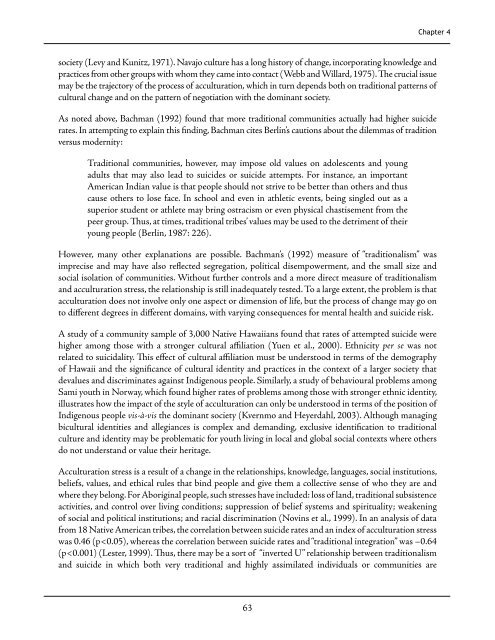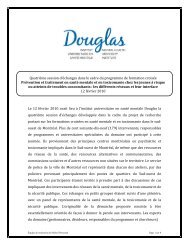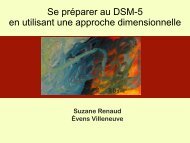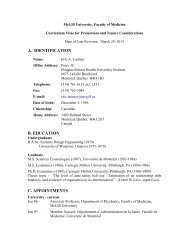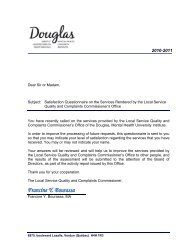Chapter 4society (Levy and Kunitz, 1971). Navajo culture has a long history of change, <strong>in</strong>corporat<strong>in</strong>g knowledge andpractices from other groups with whom they came <strong>in</strong>to contact (Webb and Willard, 1975). The crucial issuemay be the trajectory of the process of acculturation, which <strong>in</strong> turn depends both on traditional patterns ofcultural change and on the pattern of negotiation with the dom<strong>in</strong>ant society.As noted above, Bachman (1992) found that more traditional communities actually had higher suiciderates. In attempt<strong>in</strong>g to expla<strong>in</strong> this f<strong>in</strong>d<strong>in</strong>g, Bachman cites Berl<strong>in</strong>’s cautions about the dilemmas of traditionversus modernity:Traditional communities, however, may impose old values on adolescents and youngadults that may also lead to suicides or suicide attempts. For <strong>in</strong>stance, an importantAmerican Indian value is that people should not strive to be better than others and thuscause others to lose face. In school and even <strong>in</strong> athletic events, be<strong>in</strong>g s<strong>in</strong>gled out as asuperior student or athlete may br<strong>in</strong>g ostracism or even physical chastisement from thepeer group. Thus, at times, traditional tribes’ values may be used to the detriment of theiryoung people (Berl<strong>in</strong>, 1987: 226).However, many other explanations are possible. Bachman’s (1992) measure of “traditionalism” wasimprecise and may have also reflected segregation, political disempowerment, and the small size andsocial isolation of communities. Without further controls and a more direct measure of traditionalismand acculturation stress, the relationship is still <strong>in</strong>adequately tested. To a large extent, the problem is thatacculturation does not <strong>in</strong>volve only one aspect or dimension of life, but the process of change may go onto different degrees <strong>in</strong> different doma<strong>in</strong>s, with vary<strong>in</strong>g consequences for mental health and suicide risk.A study of a community sample of 3,000 Native Hawaiians found that rates of attempted suicide werehigher among those with a stronger cultural affiliation (Yuen et al., 2000). Ethnicity per se was notrelated to suicidality. This effect of cultural affiliation must be understood <strong>in</strong> terms of the demographyof Hawaii and the significance of cultural identity and practices <strong>in</strong> the context of a larger society thatdevalues and discrim<strong>in</strong>ates aga<strong>in</strong>st Indigenous people. Similarly, a study of behavioural problems amongSami youth <strong>in</strong> Norway, which found higher rates of problems among those with stronger ethnic identity,illustrates how the impact of the style of acculturation can only be understood <strong>in</strong> terms of the position ofIndigenous people vis-à-vis the dom<strong>in</strong>ant society (Kvernmo and Heyerdahl, 2003). Although manag<strong>in</strong>gbicultural identities and allegiances is complex and demand<strong>in</strong>g, exclusive identification to traditionalculture and identity may be problematic for youth liv<strong>in</strong>g <strong>in</strong> local and global social contexts where othersdo not understand or value their heritage.Acculturation stress is a result of a change <strong>in</strong> the relationships, knowledge, languages, social <strong>in</strong>stitutions,beliefs, values, and ethical rules that b<strong>in</strong>d people and give them a collective sense of who they are andwhere they belong. For <strong>Aborig<strong>in</strong>al</strong> people, such stresses have <strong>in</strong>cluded: loss of land, traditional subsistenceactivities, and control over liv<strong>in</strong>g conditions; suppression of belief systems and spirituality; weaken<strong>in</strong>gof social and political <strong>in</strong>stitutions; and racial discrim<strong>in</strong>ation (Nov<strong>in</strong>s et al., 1999). In an analysis of datafrom 18 Native American tribes, the correlation between suicide rates and an <strong>in</strong>dex of acculturation stresswas 0.46 (p
Chapter 4protected from suicide, while those <strong>in</strong> the <strong>in</strong>termediate state experience greater conflict and confusionabout identity result<strong>in</strong>g <strong>in</strong> <strong>in</strong>creased risk for suicide.Some authors, <strong>in</strong>clud<strong>in</strong>g John Berry (1980), have suggested that marg<strong>in</strong>alization <strong>in</strong>volves a sort of“deculturation” <strong>in</strong> which <strong>in</strong>dividuals acquire the skills, values, and tradition of no one culture. This describesthe situation of many <strong>Aborig<strong>in</strong>al</strong> youth—deprived of a deep education <strong>in</strong> their tradition, lack<strong>in</strong>g theknowledge and l<strong>in</strong>guistic skills of their elders, and distant or cut off from the ma<strong>in</strong>stream of Canadian societyby poverty, isolation, and educational barriers. Berry suggests that among <strong>Aborig<strong>in</strong>al</strong> youth <strong>in</strong> northernOntario, suicide “is related to the situation of be<strong>in</strong>g caught between two cultures, and be<strong>in</strong>g unable to f<strong>in</strong>dsatisfaction <strong>in</strong> either” (1993:17 as cited <strong>in</strong> Kirmayer et al., 1994b:55). Reflect<strong>in</strong>g on Inuit youth suicides<strong>in</strong> Nunavik from 1989 to 1993, anthropologist and l<strong>in</strong>guist Louis-Jacques Dorais writes: “Caught betweenlife on the land, about which they do not know enough, and the modern labour market, whose doorsseem reluctant to open up to them, many young people have developed a feel<strong>in</strong>g of be<strong>in</strong>g totally useless”(1997:69). However, the notion of deculturation is mislead<strong>in</strong>g <strong>in</strong> that even <strong>in</strong> situations of rapid change ordislocation, people reconfigure or reconstruct cultural identity and practices (Del Pilar and Udasco, 2004).Contemporary <strong>Aborig<strong>in</strong>al</strong> youth are <strong>in</strong>fluenced by diverse family and community traditions as well as massmedia and connections with other youth, both locally and globally through the Internet.EducationIn a representative sample of the general population <strong>in</strong> the United States, people who had at least ahigh school education were almost twice as likely to die by suicide than those who had less than a highschool education (OR=1.91, 95% CI=1.37–2.67) (Kung, Liu, and Juon, 1998). An analysis of data onCree communities <strong>in</strong> Quebec <strong>in</strong>dicates that <strong>in</strong>creas<strong>in</strong>g education may place women at <strong>in</strong>creased riskfor psychological distress (Kirmayer et al., 2000). This may occur because of an <strong>in</strong>creased burden ofresponsibilities and a greater frustration due to <strong>in</strong>creas<strong>in</strong>g expectations and barriers to opportunity.Several observers have noted that suicides may occur among <strong>Aborig<strong>in</strong>al</strong> youth who have had more formaleducation than their <strong>Aborig<strong>in</strong>al</strong> peers, although they may have less education than their counterparts <strong>in</strong>the non-<strong>Aborig<strong>in</strong>al</strong> population (Travis, 1983). Brant suggests that these <strong>in</strong>dividuals suffered from a senseof failure because they “may have had ambitions about participat<strong>in</strong>g <strong>in</strong> ma<strong>in</strong>stream society, but may haveencountered difficulties compet<strong>in</strong>g for jobs or recognition because they were beh<strong>in</strong>d <strong>in</strong> terms of educationalachievement” (1993:56). Similarly, <strong>in</strong> a discussion of the dramatic <strong>in</strong>crease <strong>in</strong> the suicide rate <strong>in</strong> theNorthwest Territories from 1971 to 1978, particularly among the Inuit, Rodgers (1982) noted that theperson who died by suicide was often better educated, employed, and had spent time out of the community,all of which created a discrepancy between expectations and possibilities. Others saw him as a potentialsuccess, but he was unable to confide his self-doubts or fears due to the need to ma<strong>in</strong>ta<strong>in</strong> an outward facadeof self-reliance. The suicide victim thus ma<strong>in</strong>ta<strong>in</strong>s his or her image of success—to the satisfaction of thecommunity—at the cost of a more basic level of acknowledgement and support from others.<strong>Aborig<strong>in</strong>al</strong> people liv<strong>in</strong>g on-reserve and <strong>in</strong> remote settlements are faced with the dramatic contrastbetween their immediate environment and cultural values and the larger world portrayed throughmass media that reach <strong>in</strong>to every community. In the transition to settlement life, young males may haveexperienced the greatest acculturative stress due to the discrepancies between traditional male roles ofhunter, provider, and band member and the limited economic and job opportunities of contemporarysettlement life. Young women may have found somewhat more cont<strong>in</strong>uity between traditional roles and64
- Page 1 and 2:
Suicide Among Aboriginal Peoplein C
- Page 3 and 4:
Aboriginal Healing Foundation75 Alb
- Page 6 and 7:
Table of ContentsPreface...........
- Page 8 and 9:
Table of ContentsCultural and Lingu
- Page 10:
PrefaceThis report was prepared und
- Page 14 and 15:
GlossaryAmbivalence - Ambivalence r
- Page 16 and 17:
GlossaryParasuicide - Any acute, in
- Page 18 and 19:
Chapter 1IntroductionWhen I was 14
- Page 20 and 21:
Chapter 1Definitions of Suicide and
- Page 22 and 23:
Chapter 1Methods of Studying Suicid
- Page 24 and 25:
Chapter 1suicide attempts (Marttune
- Page 26 and 27:
Chapter 1A central problem for cros
- Page 28 and 29:
Chapter 2The Epidemiology of Suicid
- Page 30 and 31: Chapter 2the economic status of Abo
- Page 32 and 33: Chapter 2No study to date has syste
- Page 34 and 35: Chapter 2Despite the overall patter
- Page 36 and 37: Chapter 2Figure 2-6) Average Annual
- Page 38 and 39: Chapter 2are only a portion of thos
- Page 40 and 41: Chapter 2Figure 2-9) Suicide Rates
- Page 42 and 43: Chapter 2Indeed, the rising rate of
- Page 44 and 45: Chapter 2Figure 2-11) Number of Dea
- Page 46 and 47: Chapter 2Rate per 100,000 populatio
- Page 48 and 49: Chapter 2There are only a handful o
- Page 50 and 51: Chapter 3Origins of Suicide: Indivi
- Page 52 and 53: Chapter 3Anxiety disorders also car
- Page 54 and 55: Chapter 3Many of the factors associ
- Page 56 and 57: Chapter 3American Indians compared
- Page 58 and 59: Chapter 3genetic and constitutional
- Page 60 and 61: Chapter 3Single-parent families are
- Page 62 and 63: Chapter 3Hopelessness, Problem Solv
- Page 64 and 65: Chapter 3higher rates of suicidal b
- Page 66 and 67: Chapter 3Physical EnvironmentSuicid
- Page 68 and 69: Chapter 31990; Chandler, 1994). Thi
- Page 70 and 71: Chapter 3Risk FactorsDepressionSubs
- Page 72 and 73: Chapter 4Origins of Suicide: Social
- Page 74 and 75: Chapter 4Reserves, Settlements, and
- Page 76 and 77: Chapter 4Traditionalism versus accu
- Page 78 and 79: Chapter 4are equivalent in seriousn
- Page 82 and 83: Chapter 4those of mother and homema
- Page 84 and 85: Chapter 4Duncan Campbell Scott, Dep
- Page 86 and 87: Chapter 4Traditional Aboriginal com
- Page 88 and 89: Chapter 4Feehan, 1996; Grant, 1996;
- Page 90 and 91: Chapter 4The Child Welfare System a
- Page 92 and 93: Chapter 4Aboriginal communities and
- Page 94 and 95: Chapter 4had extremely high rates.
- Page 96 and 97: Chapter 4Figure 4-2) Transgeneratio
- Page 98 and 99: Chapter 5What Works in Suicide Prev
- Page 100 and 101: Chapter 5Table 5-1) Strategies of I
- Page 102 and 103: Chapter 5Effective Suicide Preventi
- Page 104 and 105: Chapter 5closet rods that give way
- Page 106 and 107: Chapter 5The American Indian Life S
- Page 108 and 109: Chapter 51) school-based and commun
- Page 110 and 111: Chapter 5reduce suicides that follo
- Page 112 and 113: Chapter 5Although they may visit a
- Page 114 and 115: Chapter 6Conclusion: Understanding
- Page 116 and 117: Chapter 6Figure 6-1) An Integrative
- Page 118 and 119: Chapter 6in large urban settings th
- Page 120 and 121: Chapter 6there’s like a program s
- Page 122 and 123: Chapter 6Figure 6-2) Levels of Inte
- Page 124 and 125: Chapter 6Planning and CoordinationA
- Page 126 and 127: Chapter 62) The response to the cri
- Page 128: Chapter 6Often, suicide is a respon
- Page 131 and 132:
Appendix AASIST participants receiv
- Page 133 and 134:
Appendix AThe Training for Youth Ed
- Page 135 and 136:
Appendix AThe program has continued
- Page 137 and 138:
Appendix Awith the creation and imp
- Page 139 and 140:
Appendix AContact Information for R
- Page 142 and 143:
Appendix BAdditional Resources: Man
- Page 144:
Appendix BAboriginal Healing and We
- Page 147 and 148:
Appendix CNational Aboriginal Healt
- Page 149 and 150:
References——— (1987). Unravel
- Page 151 and 152:
ReferencesBeck, A.T., R.A. Steer, M
- Page 153 and 154:
ReferencesBrent, D.A., J.A. Perper,
- Page 155 and 156:
References——— (1995). The Pro
- Page 157 and 158:
ReferencesDevereux, G. (1961). Moha
- Page 159 and 160:
References——— (2005b). In wha
- Page 161 and 162:
ReferencesGardiner, H. and B. Gaida
- Page 163 and 164:
ReferencesGuo, B. and C. Harstall (
- Page 165 and 166:
ReferencesHoberman, H.M. and B.D. G
- Page 167 and 168:
ReferencesJong, M. (2004). Managing
- Page 169 and 170:
ReferencesKouri, R. (2003). Persona
- Page 171 and 172:
References——— (1997). Suicide
- Page 173 and 174:
ReferencesMatheson, L. (1996). The
- Page 175 and 176:
ReferencesNeimeyer, R.A., B. Fortne
- Page 177 and 178:
ReferencesPirkis, J.E., C.E. Irwin,
- Page 179 and 180:
ReferencesRutz, W. (2001). Preventi
- Page 181 and 182:
References——— (1992). Marriag
- Page 183 and 184:
ReferencesTrimble, J. and B. Medici
- Page 185 and 186:
ReferencesWebb, J.P. and W. Willard


